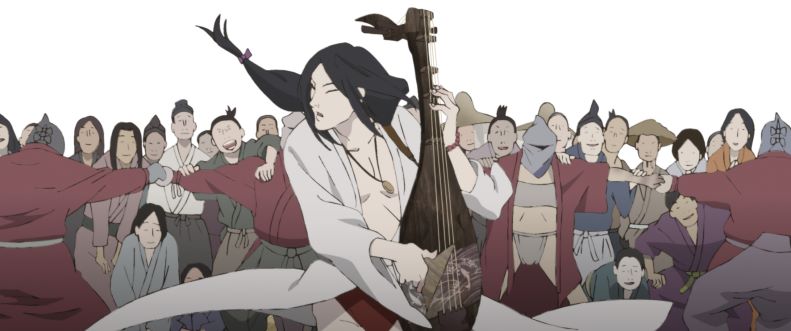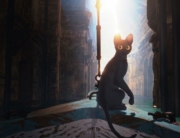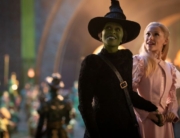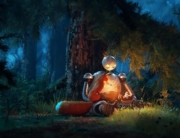Inu-Oh takes us back to 14th century Japan and brings us into the company of the downtrodden. Tomona (voiced by Mirai Moriyama), a blind musician, comes across the masked Inu-Oh (Avu-chan), who, with one long, extended arm and a hand attached to one side of his head, frightens and plays mischief on those around him—villagers call him an “ugly monster” and fearfully avoid him. Tomona has been blinded by an encounter when he, as a boy, and his father dived underwater looking for a royal relic at the request of a royal court. His father did not survive. This occurred in a period of great political instability known as the Muromachi period, in which the entire ruling Heike clan was annihilated.
More immediately, however, this animated film transports viewers to a time when music was of paramount importance to storytelling. It begins with a sung story and a tribute to Japanese Noh theater, with epic images being conjured on the screen. Tomona plays the biwa (much like a lute), and Inu-Oh not only has the ability to dance, but also sees and hears the ancient spirits of the vanquished Heike clan, who want their stories to be told. The two of them go into business together, bringing these stories to life through song and dance to massive popularity, and also to the displeasure of the authorities.
In many ways, the storytelling is bold for an animated film, where, more often than not, the assumption is that the story will be accessible by conventional standards. Not only is there some uncompromising violence, but there are long musical numbers, much unlike Disney, most of which contain important exposition and are intended to be listened to much as the sung tales of the bards, the biwa priests. In contrast, there are also periods of near silence and uneventfulness, in which seemingly humble folk quietly negotiate their war-torn world. Many of the sequences in which blind Tomona walks slowly down the road make us feel, for a moment, as though we are watching an animated film by Mizoguchi or Ozu.
These sequences are some of the strongest, for they give the movie a gentle, offhand, lifelike quality that contrasts its epic scope and make it feel different from other animated films that emphasize action. Much of the thematic material, such as the way oppressed people’s stories are silenced, is similarly resonant.
Best is the animation, which does not rip off anime classics, but is made to look as though it was done with watercolors, and is by turns naturalistic and expressionistic. There are times when the color palette is effectively drab and subdued, which gives the scenes of village life a kind of humble authenticity and adds special resonance to some of the early incursions of the supernatural. In other instances, especially when ghosts enter the action, the animators treat us to a wider spectrum of color, including rich pinks and purples.
Unfortunately, the music is less successful for it comprises an enormous portion of the running time. Ultimately, director Masaaki Yuasa places too much faith in these musical numbers to carry the story and bring the themes to light. They’re easy to get completely lost in while the tension of the story falls away. It is also both jarring and difficult to take seriously, after hearing so much of a Japanese classical score, to hear 1980s “We Will Rock You”–style anthems, which go on far too long and start to blend together. Additionally, while some of the meandering parts of the narrative are effective in their own way, it takes almost an hour for the central conflict of the story to emerge, and for much of the movie, the object of Tomona’s quest is incredibly unclear.
All in all, Inu-Oh is a film to admire more for what it attempts than what it actually achieves.







Leave A Comment